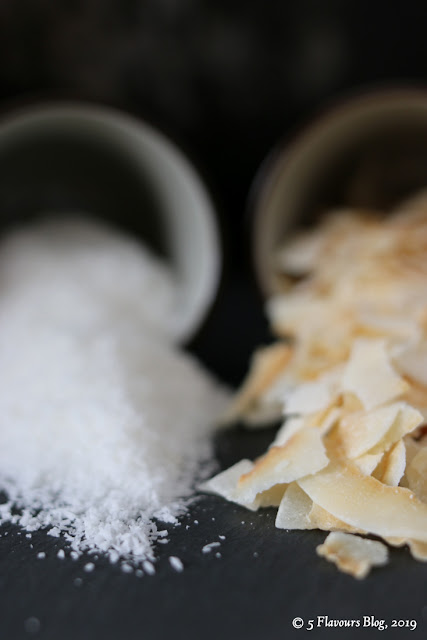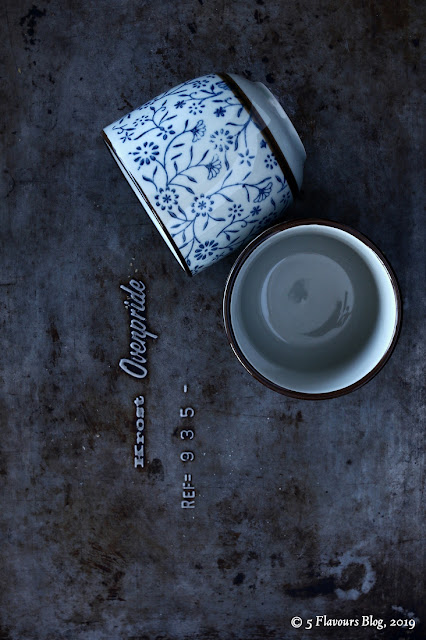Roasted Desiccated Coconut
– JUMP TO RECIPE –
– PRINT RECIPE –
Coconut – with its sleepy sweetness and rich, deceptively pervasive
flavour – reminds us of the carefree weightiness of drowsy tropical days and brilliant
white beaches gently gliding along a turquoise ocean lolling about under a slumbering
azure sky. The benign savagery of roasting coconut transforms this guileless allure
into an ardent, siren seductiveness that easily overwhelms and dominates the
irresolute and self-indulgent.
But then again: Is the stolid, perseverant life worth living if we cannot
soften its ruthlessness from time to time with a smattering of indolent luxury?
Me thinks not. And it seems roughly half the globe east of the Greenwich
Meridian may agree with me.
Coconut – in one form or another – “provides a backbone flavour in many
tropical cuisines, from southern India and Southeast Asia to Africa and South America”,
to quote our beloved Harold McGee. In the Old World of Europe and Britain the coconut remained largely
unknown until the early Middle Ages. As descendants of said Old World, we Westerners
are accustomed to coconut’s multitudinous applications for sweet dishes: mostly
tarts, cakes, desserts, confectionaries and diverse sweetmeats. However ... A
quick cross-examination of the Internet reveals a vast throng of savoury
applications particularly centering on the above mentioned regions. Conspicuously
the Tropical regions washed by that “ocean with no memory” – the vast Pacific –
demonstrate remarkable creativity and endeavour in applying the humble coconut
to a host of savoury undertakings.
The coconut tree in the Malay language is pokok seribu guna: "the tree of a thousand uses". Literally the coconut palm is quite probably the most useful tree on the planet. Briefly, it provides:
- Food and drink,
- The vessels and utensils with which to prepare, serve and transport these foods and drinks,
- Timber for housing, storage facilities and the workshops wherein the trees are transformed into useful articles,
- Thatching and basket materials,
- Fiber and textiles, and
- Oils, chemicals and medicines.
And these are merely the highlights.
The desiccated and flaked coconut for our present little project originate
from the white, meaty part (or endosperm) of the coconut. Intact or large lumps
of the meat cannot be roasted: internal heat transfer is to slow and our old,
old friend, oxygen, is excluded. Shredding and flaking is mandatory for
successfully developing the flavour through the judicious application of heat.
Desiccated coconut is manufactured by fraying out sterilized white
‘meat’ with high pressure water into a pulp, then drying it and sieving it into
grades, the finest of which is named – very satisfyingly – ‘macaroon’.
Confusingly, flaked coconut is also known as shavings; for obvious reasons. I
prefer “flaked” and will refer to it as such in this and future posts.
In contrast to other nuts, coconut has a persistent, chewy texture
unless well toasted or baked. Even then the toasted coconut needs to be kept
dry and thoroughly sealed off from moisture to prevent loss of crispness. This
ability to readily absorb moisture in the dried state attests to the
microscopically porous and fibrous nature of the original ‘meat’. The high
water content and composition of the meat contributes to the nature of the
toasted product:
- ± 45% Water
- ± 35% Fat – mostly saturated oils that enthusiastically contribute to raising blood cholesterol levels
- ± 10% Carbohydrate
- ± 5% Protein
The source of the coconut’s distinctive and pervasive rich, sweet aroma (and taste) originates in a class of compounds called lactones. These are fatty acid derivatives (cyclic carboxylic acid esters, to be precise) and those of the coconut are thermally stable, thus explaining why the flavour and taste persist throughout cooking and baking processes.
Coconut has several well established food pairings. As a main
ingredient, the milk, cream or shredded coconut goes very well with:
- Apricots
- Bananas
- Chocolate
- Custard
- Fruits – particularly tropical fruit such as limes, mangoes & passion fruit
- Nuts – particularly Brazil, cashew and macadamia nuts
- Pineapple
As flavouring agent, the popular coconut seasoning pairings are:
- Chicken
- Custard
- Fruit
- Oranges
- Shellfish
Carefully applying heat and oxygen through oven-roasting or pan-toasting (on a stove top) coconut meat generate the desirable generic nutty flavour tones that enhance and significantly amplify desiccated coconut’s usefulness. Heating releases reactive pyrazines, pyrroles and furans through oxidation and pyrolysis reactions of the above mentioned lactones and other components found in the meat. However, vigilance is required as going too far will cause excessive Maillard reactions, destructive oxidation and eventual charring & carbonisation; destroying desirable flavours, ruining textures and giving rise to virulent bitterness and devastation.
Oven roasting shredded coconut is an efficient and easy method to
amplify, improve and deepen the humble coconut’s flavour profile for use in
dishes where other strong and domineering flavours and tastes are – or will be
– present. The nutty and drowsy richness of toasted coconut can thus be
elevated to an equal partner status as opposed to playing a lesser, supportive
role in the flavour profile of many a savoury dish or baked item.
One caveat: on South African grocery store shelves we predominantly see artificially sweetened desiccated coconut as a direct acknowledgement of our national sweet tooth. Or should it be ‘teeth’? Anyway, this forces the intrepid cook to oven roast desiccated coconut at a somewhat less than optimal temperature to prevent scorching and charring. Pan toasting the sweetened desiccated coconut becomes an operation requiring high vigilance, constant stirring and deft manipulation of the heat under the pan. Better to roast than to toast then to prevent wrack and ruin.
ROASTED DESICCATED COCONUT
Preparation time:
± 5 Minutes
|
Baking time:
5 – 10 Minutes
|
Ingredients:
Desiccated or flaked
coconut
|
75g
|
Method:
- Spread the desiccated or flaked coconut out evenly over a suitably sized oven tray or Swiss roll pan. Make sure the coconut layer is no deeper than two match sticks.
- Roast at ± 165°C (330 deg F) on the middle shelf of a convection oven. Turn the pan or tray halfway through. Visually check the roasting coconut frequently.
- For desiccated coconut: roast 7 – 10 minutes depending on the desired level of browning required.
- For flaked coconut: roast no longer than 5 minutes. Be wary of roasting the flakes too far as this will introduce an astringent bitterness to the end product which is difficult to disguise in the final dish, particularly when you are in a hurry.
- Roast at ± 180°C (360 deg F) in a non-convection oven and add ± 8 – 10 minutes roasting time.
- Cool to room temperature and seal in a suitable container. Store in a cool, dry place away from direct sunlight.
Comments:
- Flakes allow for more efficient hot air movement in the oven; thus roasting much faster than desiccated coconut.
- Non-convection ovens tend to have internal hot spots and non-uniform heat distribution. Roasting desiccated coconut in these ovens requires frequent visual inspection and stirring the roasting coconut (desiccated and flaked kinds) from time to time to ensure even roasting.
- The roasted coconut should be used within three weeks.
© RS Young, 2019
Sources:
1.
McGEE ON FOOD & COOKING, An Encyclopedia of Kitchen Science, History and
Culture; McGee, Harold; Hodder & Stoughton; London; 2004.
2.
THE PENGUIN COMPANION TO FOOD; Davidson, Alan; Penguin Books (U.K.); 2002.
[Originally published as the “Oxford Companion To Food” in 1999 by Oxford
University Press]
3.
THE FLAVOUR THESAURUS; Segint, Niki, Bloomsbury Publishing; London; 2010.
4.
COOKING WITH SPICES; Heal, Carolyn & Allsop, Michael; Panther Books
(Granada Publishing Ltd); London; 1985.
5.
CULINARY ARTISTRY; Dornenburg, Andrew & Page, Karen; John Wiley & Sons,
Inc.; 1996.
6.
COCONUT: https://en.wikipedia.org/wiki/Coconut; Retrieved on 19/06/2019.
– RECIPE INDEX PAGE –
Follow Me on Facebook
Note:
Post updated on 2025.01.19 to include:
1.
The updated Recipe for downloading as a PDF file, and
2.
Recipe Title and Print Recipe, Recipe Index and Facebook & Pinterest follow
links.










Comments
Post a Comment